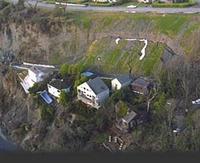-
Quake-triggered landslides a significant hazard for Seattle

Seattle is prone to strong shaking as it sits atop the Seattle Basin — a deep sedimentary basin that amplifies ground motion and generates strong seismic waves that tend to increase the duration of the shaking. A new study suggests the next big quake on the Seattle fault may cause devastating damage from landslides, greater than previously thought and beyond the areas currently defined as prone to landslides.
-
-
U.S. first nuke in thirty years mired in costly legal wrangling
The U.S. first nuclear construction project in thirty years is the center of a $900 million lawsuit pitting Westinghouse Electric Co. against Georgia Power. The $14 billion project is about twenty months behind schedule and $900 million over budget, and each side blames the other for the delays and cost overruns.
-
-
The only effective asteroid defense: early detection – and evacuation of impact area

For the threat of meteor strikes large or small, early detection is key, and evacuation may be the only defense needed within the next 1,000 years, according to an asteroid impact expert. He says that the best investment in asteroid defense is not in weapons to deflect them, but in telescopes and surveys to find them.
-
-
Irish heritage groups sues U.K. over nuclear power plant
An Taisce, an Irish charity group promoting the preservation of Ireland’s heritage, is taking the British government to the High Court in London in December seeking a judicial review of the legality of British energy minister Ed Davey’s decision to approve the construction of a nuclear power plant just 150 miles from the Irish coast without consulting the Irish public.
-
-
Weatherizing U.S. homes to uniform standard to save $33 billion a year
The U.S. residential sector — 113 million homes — uses about 23 percent of total U.S. source energy annually (source energy includes site energy, the energy consumed by buildings for heating and electricity, as well as the raw energy required to transmit, deliver and produce it). A new study finds that upgrading buildings’ airtightness to a uniform level could achieve as much as $33 billion in annual energy savings.
-
-
Better protective shield material for nuclear waste
The integrity and survivability of a nuclear waste package is critically important in the transport of nuclear fuel and high-level waste. Research are working on developing an outer shield material for use in packaging which is resistant to corrosion, radiation, diffusion, and thermal cycling processes that affect fuel packages during long-term storage. The material will also need to be wear-tolerant and mechanically robust so that it can survive repeated handling and transportation.
-
-
Geologists: Sandy could happen again
Sandy’s storm surge hit the coast at high tide, but storm and tidal conditions were not the only cause of the devastation. Seawaters off New York’s coast have risen sixteen inches since 1778, the year of New York City’s first major recorded storm. Geologists say that due to rising sea levels, smaller storms could produce significant flooding.
-
-
New barrier system to protect Venice from rising seas

The City of Venice, Italy has carried out the first test of its $7.3 billion barrier system designed to protect the city from rising sea levels. The system, known as MOSE (MOdulo Sperimentale Elettromeccanico), consists of seventy-eight mobile barriers divided into four sections at the three inlets to the Venice lagoon.
-
-
Using hills to shelter buildings from tornadoes
Researchers have demonstrated the influence of hills on tornadoes. The researchers’ models revealed that the height of a hill and the size of a tornado’s vortex have a significant effect on the tornado’s destructive power. The findings could be used to identify safer areas for construction.
-
-
U.S. formulates strategy for a new Arctic landscape
U.S. national security officials have become increasingly concerned about the national security implications of an ice-free Arctic. The Arctic will become ice-free during the summer by mid-decade. In a strategy document, the Pentagon says: “Melting sea ice in the Arctic may lead to new opportunities for shipping, tourism, and resource exploration, but the increase in human activity may require a significant increase in operational capabilities in the region in order to safeguard lawful trade and travel and to prevent exploitation of new routes for smuggling and trafficking.”
-
-
U.S. nuclear power industry facing growing challenges
The U.S. nuclear industry is scaling back expectations on the future of the industry, expectations which only a few were soaring. The availability of cheaper energy alternatives, a growing trend toward energy conservation, and renewed safety and health worries as a result of the 2011 Fukushima Daiichi Nuclear Power Plantaccident, are all reasons for why active nuclear plants are being forced to close, and why fewer energy companies are investing in new nuclear plants or upgrading existing ones.
-
-
Canadian city developed mathematical formula to evaluate risk
The City of Hamilton, Ontario has ranked Terrorism fourth on its list of top ten emergency risks, below Hazardous Materials and Explosions, Energy Supply Emergencies, and Epidemics/Pandemics.The city’s ranking of top 10 emergencies for which it plans is not a mere judgment call: The city’s emergency management office uses a mathematical equation to rate the risks to the city and its population.
-
-
Maryland preparing for sea level rise
Maryland has 3,100 miles of tidal shoreline. A scientific report recommends that it would prudent for the state to prepare for a sea level rise of 1.4 feet by 2050.Maryland’s CoastSmart Communities Initiative (CCI) provides grant funding for coastal communities which want to reduce their vulnerabilities to the effects of coastal hazards and sea level rise by becoming ready, adaptive, and resilient.
-
-
Maryland preparing for sea level rise
Maryland has 3,100 miles of tidal shoreline. A scientific report recommends that it would prudent for the state to prepare for a sea level rise of 1.4 feet by 2050.Maryland’s CoastSmart Communities Initiative (CCI) provides grant funding for coastal communities which want to reduce their vulnerabilities to the effects of coastal hazards and sea level rise by becoming ready, adaptive, and resilient.
-
-
Renewable fuel standard: mend it, don’t end it
Congress should minimally modify — and not, as petroleum-related interests have increasingly lobbied for, repeal — the Renewable Fuel Standard (RFS), the most comprehensive renewable energy policy in the United States, according to a new paper. The paper argues that RFS mandates merely ought to be adjusted to reflect current and predicted biofuel commercialization realities.
-
More headlines
The long view
Water Wars: A Historic Agreement Between Mexico and US Is Ramping Up Border Tension
As climate change drives rising temperatures and changes in rainfall, Mexico and the US are in the middle of a conflict over water, putting an additional strain on their relationship. Partly due to constant droughts, Mexico has struggled to maintain its water deliveries for much of the last 25 years, deliveries to which it is obligated by a 1944 water-sharing agreement between the two countries.
Trump Is Fast-Tracking New Coal Mines — Even When They Don’t Make Economic Sense
In Appalachian Tennessee, mines shut down and couldn’t pay their debts. Now a new one is opening under the guise of an “energy emergency.”
Smaller Nuclear Reactors Spark Renewed Interest in a Once-Shunned Energy Source
In the past two years, half the states have taken action to promote nuclear power, from creating nuclear task forces to integrating nuclear into long-term energy plans.
Keeping the Lights on with Nuclear Waste: Radiochemistry Transforms Nuclear Waste into Strategic Materials
How UNLV radiochemistry is pioneering the future of energy in the Southwest by salvaging strategic materials from nuclear dumps –and making it safe.
Model Predicts Long-Term Effects of Nuclear Waste on Underground Disposal Systems
The simulations matched results from an underground lab experiment in Switzerland, suggesting modeling could be used to validate the safety of nuclear disposal sites.
